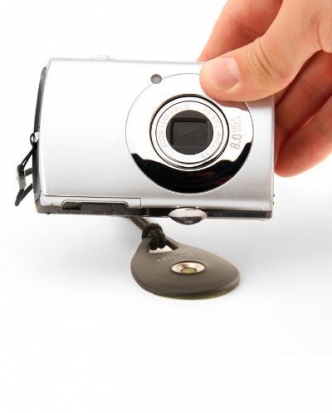
When I was first asked if I'd test-drive a tiltpod, I shrugged my shoulders and thought 'Why not?' A portable, tiltable compact camera or iPhone securing device? There are worse things I could be asked to do, even if I weren't quite sure how I'd end up using them.
About a month on, I love my iPhone tiltpod and I can see the benefit of the compact camera version.
Tiltpods come with a lightweight, magnetic base that's set with a small socket, and a corresponding magnetic ball joint that either screws into the tripod mount of your compact camera or has a slot for your iPhone 4 or 4S. The ball sits in the socket, is held there by the marvel that is magnetism, and being a ball-and-socket, rotates. Rather than being tripods, they're more like gastropods, I suppose.
The camera version's base attaches to your camera via a lanyard and the ball joint is unobtrusive enough to live permanently in the tripod mount. (If you've an off-centred tripod mount, there is a sticky ball joint, instead.) It's a clever bit of design: the chances of losing one bit or the other have been diminished whilst the possibility of actually using it is increased by virtue of it always being there. As for the iPhone version, it can dangle most comfortably from your keyring.
Now that the ergonomics have been covered, what about using the things? Quite serendipitously, a project that is currently consuming just about all of my waking moments has demanded a heap of iPhoneography recently. The tiltpod has proved its mettle here, especially when it came to self-portraits. Find a flat surface, set the angle, use your self-timer function of choice, and away you go. Even if you don't need to be quite so artistically-inclined as my endeavours, a tiltpod is still ideal for grabbing photos of you and your beloveds, instead of pictures with oddly angled arms or devoid of one of your party.
Or you could just use it for Facetiming, if that's more your thing.
As for the camera version, it's pretty much the same deal. Find your surface, set it up, off you go. I've not had any issues with wobble, slide, or slip, and positioning it has been a question of how daring I've felt.
Tiltpods aren't without their limitations, though. Unless you magnetically attach the base to a radiator, lamppost, or railing, you're restricted to taking landscape oriented photos with the camera version. Whether or not you've the stomach to dangle your P310 from a balustrade via a magnet is up to you. I mean, I tried it, in the interests in writing a review, but I don't know if I'd be prepared to step beyond catching distance of my camera lest gravity get the better of it. (The tiltpod team does point out you can always attach the sticky ball joint to your camera to facilitate vertically-oriented shooting, but if you're already using the sticky foot, you can't. And you might not want to stick a sticky foot to your camera, either.)
If you precision-angle your iPhone, you can stand it vertically in its tiltpod. This set up does, however, feel a little precarious for my comfort. I would have apreciated just a little more depth and width in the base, so that I could use it to take portraits and not have to worry about my iPhone tumbling into oblivion, or have my iPhone standing up on my desk without fear of it toppling over should a door slam. Still, it hasn't stopped me from using the tiltpod to cradle my phone on my desk horizontally.
Finally, they do need to sit on a surface: a wall, a shelf, a nest of tables that I stacked one of top of another to gain sufficient height for one particular photo. But the problem itself isn't insurmountable (although my furniture obstacle course might have been) and it's the trade-off for their significant advantage over other camera-stabilising devices: they are emininetly portable.
The camera version stays attached to your camera, so it goes with you (and your camera) automatically. The iPhone version attaches to your keyring. They're designed to be used, not left languishing in a drawer or at the bottom of a bag.
At a smidge under $15 each, a tiltpod doesn't break the bank, although I'll admit that I probably wouldn't have gone out and bought one for myself. I am, though, very happy to have them in my possession. If you do lots of iPhoneography (or Facetime frequently), the iPhone version is worth it. And I reckon that they make pretty nifty presents, too.
Tiltpods are available from Gomite's webstore, costing $14.95 each.
Disclaimer: Gomite did send me two unsolicited review models. I didn't pay for them and I have been allowed to keep them.





